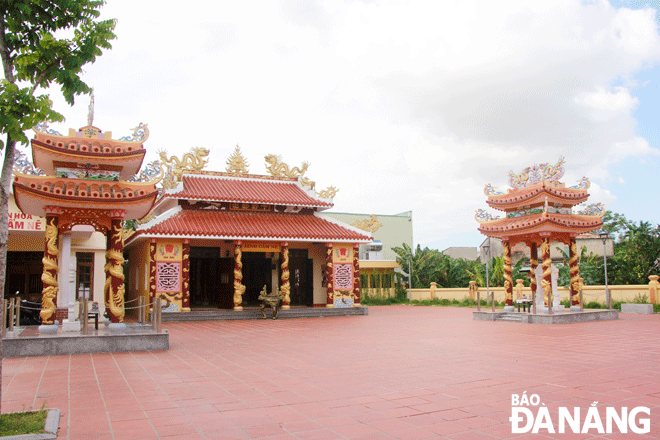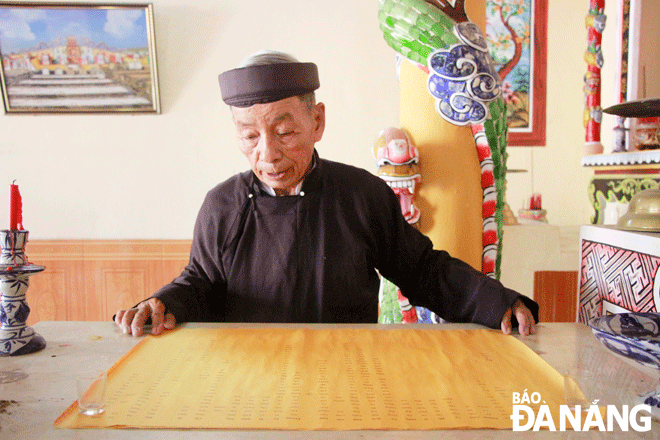Cam Ne village communal house - A place to preserve tradition and history
Referring to the Cam Ne Village, Hoa Tien Commune, Hoa Vang District, Da Nang, many people immediately think of the traditional mat weaving handicraft that was once famous throughout Central Viet Nam.
However, talking about Cam Ne, it is impossible not to mention the namesake village communal house which has been recognised as a municipal-level historical relic site by the Da Nang government.
 |
| Cam Ne village communal house has a large yard where cultural exchange activities often take place. Photo: X.D |
A witness of hero homeland
Located on a nearly 1,600m2 land in the center of Cam Ne Village, the village communal house faces south and features such architectural units as communal house gate, stele houses on both sides and village communal house.
The venue is both a center of beliefs, culture and education, as well as a symbol reflecting the village’s beautiful traditional nuances and values.
According to 79-year-old Ngo Van Mua, Head of the Cam Ne Village, said that, although the exact year of construction of the village communal house could not be determined, it can be estimated that the communal house was built about 600 years ago between the early Le and the Mac dynasties.
The communal house was located in the middle of the village, on an acre of land built up to two meters high by the villagers. And, it was originally made of thatch, bamboo and leaves.
At that time, the Cam Ne communal house was both a center of beliefs, culture, and education, as well as a place to preserve fine customs, traditions and good traditions of villagers.
According to the heritage guide Le Van Phuc - an officer of the Museum of Da Nang, the outstanding value of the Cam Ne village communal house is the historical value of the revolution.
The village communal house marked many important victories in the two resistance wars against the French colonialists and the American imperialists. This was a place to shelter, meet and exchange information between neighbouring localities, to teach the national language, to provide food and medicine, and to serve as a springboard for big battles in the city center.
The most memorable milestone was that under the US soldiers’ attack named Zippo, the Cam Ne Village was burned, and destroyed. All villagers scattered everywhere. However, villagers still secretly returned to work and served the revolutionary wars, building many secret shelters in the communal house.
“In any circumstances, the Cam Ne village communal house is always the fulcrum for the resistance war of soldiers and people in Hoa Vang District in particular, and in Quang Nam - Da Nang in general, making an important contribution to the success of the 1975 Spring Offensive" Mr. Phuc emphasised.
 |
| Mr. Ngo Van Mua, Head of the Cam Ne Village, preserves royal ordination documents as valuable asset to pass on to the next generation. Photo: X.D |
Promoting traditional identity
During the resistance wars, the Cam Ne Village Communal House was completely destroyed by the enemy, so all artifacts, documents and royal ordination documents are now lost.
After many times of reconstruction, the architecture of the communal house no longer retains its original features compared to the early period and has interfered with modern architecture.
However, the overall house today still shows the tradition through each architectural unit and decoration style. One example is the roof covered with yin and yang tiles.
According to Mr. Ngo Van Mua, seven ceremonial activities are being organised at the Cam Ne Village Communal House every year, including Thanh Minh Festival, and solemn rituals to honour ancestors and to pray for peace, happiness and prosperity throughout the year.
Among them, a ceremony to express gratitude to ancestors of the Le clan on the full moon of March every year is the biggest of its kind.
In addition, the communal house yard is also the place where cultural exchange activities take place.
“All Cam Ne villagers are extremely happy and excited when the communal house was recognised as a municipal-level relic site. This is the basis for us to continue preserving and restoring the cultural identities left by our ancestors; in which, there are customs associated with the communal house" Mr. Mua said.
The Cam Ne land boasts many historical and cultural values, especially the famous traditional mat weaving. Therefore, Cam Ne village communal house is becoming an inviting destination for both locals and visitors to learn about Cam Ne Village.
According to Mr. Nguyen Duy Tan, cultural officer of Hoa Tien commune, when the Cam Ne communal house has been classified as a municipal-level relic site, the locality will set up a management board to preserve and clean up the village, as well as organise ceremony activities there.
Also, they plan to add the traditional mat weaving of Cam Ne village into the Cam Ne village communal house festival, aiming to create a playground for locals and contribute to preserving the traditional beauty of the homeland.
Reporting by XUAN DUNG - Translating by M.DUNG